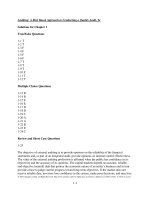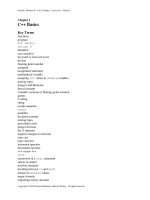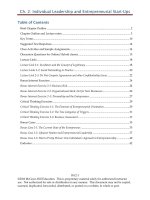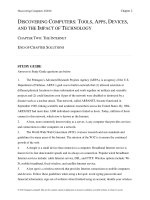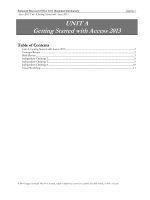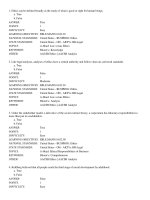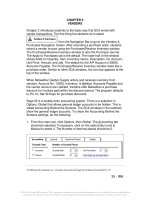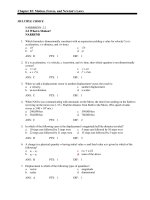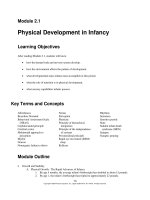Test bank and solution manual of discovering computer (1)
Bạn đang xem bản rút gọn của tài liệu. Xem và tải ngay bản đầy đủ của tài liệu tại đây (275.43 KB, 11 trang )
Discovering Computers ©2014
Chapter 2
DISCOVERING COMPUTERS: TECHNOLOGY IN A
WORLD OF COMPUTERS, MOBILE DEVICES, AND THE
INTERNET
CHAPTER TWO: THE INTERNET
END OF CHAPTER SOLUTIONS
STUDY GUIDE
This study guide identifies material you should know for the Chapter 2 exam. You may
want to write the answers in a notebook, enter them on your digital device, record them into a
phone, or highlight them in your book. Choose whichever method helps you remember the best.
1. Explain how ARPANET contributed to the growth of the Internet.
ARPANET built a network of four main host computers, or servers in 1969. Today,
millions of hosts connect to this network, which is now known as the Internet.
2. Describe the role of a host on a network.
A host is any computer that provides services and connections to other computer on a
network.
3. Identify the role of the W3C.
The W3C oversees research and sets standards and guidelines for many areas of the
Internet.
4. Define the term, broadband. List popular wired and wireless broadband Internet services.
Broadband Internet service has fast data speeds and an always-on connection. Popular
wired broadband Internet service technologies include: cable internet service, DSL, and
FTTP. Popular wireless broadband Internet service technologies include: Wi-Fi, mobile
broadband, fixed wireless, and satellite Internet service.
5. State the purpose of a hot spot and where you might find one.
A hot spot is a wireless network that provides Internet connections to mobile computers
and devices. Many public locations, such as airports, hotels, schools, malls, coffee shops,
and city parks are hot spots.
6. ISP stands for _____.
ISP stands for Internet service provider.
7. Briefly describe how data and information travel the Internet.
1
Discovering Computers ©2012
Chapter 2
Data and information travel on the Internet by transferring from one network to another
until reaching the final destination.
8. Describe the purpose and composition of an IP address. [EB] What are IPv4 and IPv6?
An IP address is a sequence of numbers that uniquely identifies the location of each
computer or device connected to the Internet. An IP address consists of numbers
separated by periods or colons. IPv4 and IPv6 are addressing schemes for IP addresses.
IPv6 added additional length to IP address, increasing the number of possible addresses.
9. Define the term, domain name.
A domain name is a text-based name that corresponds to the IP address of a server that
hosts a website.
10. Identify the purpose of several generic TLDs. Identify ICANN’s role with TLDs.
Popular TLDs include: .com (commercial organizations), .edu (educational), .gov
(government), .mil (military), .net (network providers), and .org (nonprofits). ICANN
approves and controls TLDs.
11. Describe how and why cybersquatters register domain names.
Cybersquatters buy and register unused or lapsed domain names so that they can profit
by selling them.
12. State the purpose of a DNS server.
A DNS server translates a domain name to its IP address.
13. Differentiate between static and dynamic webpages.
A static webpage displays the same content to all visitors. A dynamic webpage customizes
some or all of the viewed content based on the user’s preferences or past experience.
14. Distinguish among the web, a webpage, a website, and a web server.
The web is a worldwide collection of electronic documents. A webpage is an electronic
document on the web. A website is a collection of related webpages and associated items.
A web server is a computer that delivers requested webpages to computers and mobile
devices.
15. Explain the purpose of a browser. List ways you can browse safely.
A browser is an application that enables users with an Internet connection to access and
view webpages on a computer or mobile device. Safe browsing techniques include:
verifying the website is safe, clearing your browser history, using a phishing filter,
enabling a pop-up blocker, and browsing anonymously.
16. Name examples of popular browsers for personal computers and mobile devices.
Popular browsers for personal computers include Chrome, Firefox, Internet Explorer,
Safari, and Opera. Mobile browsers include opera Mini, Safari, Google Android’s
browser, Google Chrome, Firefox Mobile and Internet Explorer Mobile.
17. Describe the function of tabbed browsing.
Discovering Computers ©2014
Chapter 2
Tabbed browsing uses tabs to display multiple webpages in a browser window.
18. [EB] Explain how a phishing filter can protect you.
A phishing filter warns or blocks you from potentially fraudulent or suspicious websites.
19. Define the term, web address. Name a synonym.
A web address is the unique address of a webpage. A web address is also called a URL.
20. Name and give examples of the components of a web address.
A web address incudes protocol (http), host name (www), domain name (nps.gov), path
(history/), and/or filename (places.htm).
21. Describe the purpose of a web feed and the role of a feed reader.
A web feed contains content that has changed on a webpage. A feed reader reads a user’s
specified web feeds and collects their most recent content.
22. Explain the relationship between web and mobile apps.
A web app is an application stored on a web server that you access through a browser. A
mobile app is an application you download to a mobile device. Services such as banks
and email often sync their web app and mobile app versions so you can access the data
from anywhere you have an Internet connection, regardless of the computer or device
used.
23. Describe the purpose of GPS receivers, and why they are embedded in smartphones.
A GPS receiver is a handheld, mountable, or embedded device that contains an antenna,
radio receiver, and processor. Most smartphones include GPS receivers to that users can
determine their location, obtain directions, and locate points of interest.
24. Besides webpages, identify other items a search engine can find.
Search engines can locate: images, videos, maps, audio, publications, people or
businesses, and blogs.
25. [EB] Name the products or services of Yahoo! and Google, with respect to browsing.
Yahoo! and Google are popular websites that includes email, search services, and more.
26. Describe how to use a search engine. What are some ways you can refine a search?
Search engines require that you enter a word or phrase, called search text, to describe
the item you want to find. To improve your results, use specific nouns, put the most
important terms first, list all possible spellings, read the search engine’s Help
information, and try other search engines.
27. Differentiate between a search engine and a subject directory.
A search engine provides results based on the search terms a user provides. A subject
directory classifies webpages in an organized set of categories, such as sports or
shipping.
3
Discovering Computers ©2012
Chapter 2
28. Explain how to use a social networking site for personal or business uses.
You can use a social networking site for personal use to share photos, videos, personal
greetings, and status updates; recommend or like online content; and check in a
locations. Business uses include connecting with customers, providing promotional
offers, and targeted advertisements.
29. List ways to use social networking sites securely.
Social networking site safety tips include; choose friends carefully, limit friends, prohibit
email address book scams, divulge only relevant information, be leery of urgent requests
for help, read the privacy policy, and manage your profile.
30. Describe the purpose of these types of websites: informational; media sharing and
bookmarking; news, weather, and sports; educational; business, governmental, and
organizational; blogs; wikis; health and science; entertainment; financial; travel and
mapping; shopping and auctions; career and employment; and portals.
Informational websites contain factual information. Media sharing and bookmarking
websites enables members to manage and share media. News, weather, and sports
websites contain newsworthy material. Educational websites offer avenues for formal
and informal teaching and learning. Business, governmental, and organizational
websites provide customers and citizens with information. Blogs are informal websites
consisting of time-stamped articles in a diary or journal format. Wikis enable users to
organize, edit, and share information. Health and science websites provide information
for public access, or for professionals to share information. Entertainment websites offer
music, videos, shows, performances, events, and more. Financial websites enable users to
access financial records, use online banking, and make investments. Travel and mapping
websites enable users to reserve a flight, hotel, or vehicle. Shopping and auction websites
enable you to purchase products and services. Career and employment websites provide
career information and job listings. Portals provide a variety of Internet services from
one location.
31. List techniques to protect yourself from identity theft.
Guidelines to protect yourself from identity theft include: do not tap or click links in
spam, install a firewall, clear or disable cookies, turn off file and printer sharing, set up a
free email to use for merchant forms, and more.
32. Describe ways you can shop online safely.
Online shopping safety tips include: read customer reviews, look for seals of approval,
create a strong password, check website details, and beware of requests to supply further
information.
33. List some criteria you can use to narrow your search for a job online.
To narrow your job search online, enter relevant keywords, select an appropriate
category, and limit your results to a geographic area.
34. Define the term, e-commerce. Differentiate among B2C, C2C, and B2B e-commerce.
E-commerce is a business transaction that occurs over an electronic network such as the
Discovering Computers ©2014
Chapter 2
Internet. B2C is the sale of goods and services to the general public. C2C is when
consumers sell directly to each other, and B2B is when businesses provides goods and
services to other businesses.
35. List the seven criteria for evaluating a website’s content.
The seven criteria for evaluating a website’s content are: affiliation, audience, authority,
content, currency, design, and objectivity.
36. Identify and briefly describe the steps in web publishing.
The steps in web publishing are:
Plan: identify the purpose and audience.
Design: select appearance, layout, colors, and formats. Determine content.
Create: use a word processing program, content management system, website
authoring software, text editor, and possibly website management software.
Host: transfer the webpage from your computer to a web server.
Maintain: keep contents current and ensure links work properly.
37. _____ refers to any application that combines text with media.
Multimedia refers to any application that combines text with media.
38. Describe website accessibility guidelines.
Website accessibility guidelines increase access for all users, including those with poor
eyesight or color blindness; tremors and loss of muscle control; hearing loss; seizure
disorders, and other disabilities including dyslexia.
39. Explain how webpages use graphics, animation, audio, video, virtual reality, and plugins.
A graphic is a visual representation of nontext information. An animation is a series of
still images to create motion. Audio includes music, speech, or other sound. Video clips
consist of images displayed in motion. Virtual reality is the use of computers to simulate
a real or imagined environment that appears as a 3D space. Plug-ins are programs that
a browser uses to display multimedia elements on a webpage.
40. Define the terms, thumbnail and infographic.
A thumbnail is a small version of a larger object that you usually can tap or click to
display a larger image or object. An infographic is a visual representation of data or
information.
41. Name the types of graphics formats used on the web and how they use compression.
JPEG and PNG formats are commonly used on the web. JPEG balances image quality
and file size, so the more it is compressed the smaller the image is. PNG is a compressed
format that restores all image details when the file is viewed.
42. Describe the purpose of these Internet services and explain how each works: email, email
lists, instant messaging, chat rooms, discussion forums, VoIP, and FTP.
Email is the transmission of messages and files via a computer or network. An email list
5
Chapter 2
Discovering Computers ©2012
is a group of email addresses used for mass distribution of a message. Instant messaging
is real-time Internet communications that allow you to exchange message or files. Chat
rooms are websites or applications that permit users to chat with others who are online
at the same time. Discussion forums are online areas in which users have written
discussions about a subject. VoIP enables users to s peak to other users via their Internet
connection. FTP permits file uploading and downloading to and from other computers on
the Internet.
43. Describe the components of an email address.
An email address consists of a user name and domain name.
44. _____ refers to Internet communication in which both parties communicate at the same
time.
Real-time refers to Internet communication in which both parties communicate at the
same time.
45. [EB] Describe how the following use digital communications: home users, small
office/home office users, mobile users, power users, and enterprise users.
Home users use digital communications to communicate with family members, research
and request services, view recipes, and more. Small office/home office users use financial
software, social media, GPS, and more. Mobile users use smartphones and tablets to take
notes, make mobile payments, send texts, and more. Power users use supercomputers and
Internet services to conduct research or do large-scale projects. Enterprise users use
handheld devices and databases to manage inventory, and more.
46. Define the term, netiquette.
Netiquette is the code of acceptable behaviors users should follow while on the Internet.
47. Define the term, social media. List forms of social media.
Social media consists of content that users create and share online, such as photos,
videos, music, links, blog posts, and more.
48. Describe cyberbullying, and explain why it is difficult to catch the perpetrators.
Cyberbullying is harassment using technology. The anonymity of the Internet and
variations in laws and policies make it difficult to catch and prosecute the perpetrators.
CHECKPOINT
1.
2.
3.
4.
5.
TRUE/FALSE
MULTIPLE CHOICE
MATCHING
T
F
T
F
T
A
C
C
B
D
E
I
A
G
J
Chapter 2
Discovering Computers ©2014
6.
7.
8.
9.
10.
11.
12.
F
T
F
T
T
F
F
B
D
A
H
B
F
C
D
SHORT ANSWER
1. A cybersquatter buys and registers unused or lapsed domain names so that they can profit
from selling them. The goal of the Anticybersquatting Protection Act (ACPA) is to protect
trademark owners from being forced to pay a cybersquatter for a domain name that includes
their trademark.
2. Phishing is a scam in which a perpetrator attempts to obtain your personal and/or financial
information. Safe browsing techniques include: verify a website is safe, clear your browsing
history, use a phishing filter, enable a pop-up blocker, and browse anonymously.
3. Types of websites include: search engines; online social networks; informational; media
sharing and bookmarking; news, weather, sports, and other mass media; educational;
business, governmental, and organizational; blogs; wikis; health and science; entertainment;
financial; travel and mapping; shopping and auctions; careers and employment; portals; and
e-commerce. Guidelines to avoid privacy and security risks on online social networks
include: choose friends carefully, limit friends, prohibit email address scams, divulge only
relevant information, be leery of urgent requests for help, read the privacy policy, and
manage your profile.
4. Tips to shop safely online include: read customer reviews, look for seals of approval, create a
strong password and password questions, check website details, and beware of requests to
supply further information. E-commerce, which is short for electronic commerce, is a
business transaction that occurs over an electronic network such as the Internet. Mcommerce, which is short for mobile commerce, refers to e-commerce that takes place using
mobile devices.
5. Evaluate a website by considering the following: affiliation, audience, authority, content,
currency, design, and objectivity. The steps in web publishing are: 1) plan the website, 2)
design the website, 3) create the website, 4) host the website, and 5) maintain the website.
CONSIDER THIS
1. Answer the critical thinking questions posed at the end of these elements in this chapter:
Ethics & Issues (8, 22, 34, 38), How To (5, 20, 21, 27, 27), Mini Features (10, 32, 40),
Secure IT (18, 23, 24, 30), and Technology @ Work (41).
Student answers will vary.
2. What are the advantages of using a broadband Internet service? (56)
A broadband Internet service has fast data speeds and an always-on connection.
7
Discovering Computers ©2014
Chapter 2
3. What is the relationship between domain names and IP addresses? (59)
An IP address is a sequence of numbers that uniquely identifies the location of a
computer or device connected to the Internet. A domain name is its text-based
counterpart.
4. Is cybersquatting ethical? Why or why not? (60)
Cybersquatting is not ethical, because it is an attempt to force trademark owners to pay
for a domain name that includes their trademark.
5. How does Web 2.0 technology affect the way you interact with the Internet? (62)
Web 2.0 refers to websites that provide a means for users to share personal information,
modify website content, and access applications through a browser.
6. What type of information is protected when you browse the web anonymously? (62)
When you browse the web anonymously your online identity is protected, and your
browsing history, passwords, user names, and personal information is hidden.
7. What are the advantages and risks associated with allowing an app to track your location?
(66)
When you allow an app to track your location, you can find driving directions, coupons,
or restaurant tips, and share your location with friends. Others can track your location
without your knowledge, such as thieves who know your location or whether your home
is empty.
8. Would you use a wiki as a resource when writing a research paper? Why or why not? (73)
Wikis are user-editing and created content sharing websites. Sometimes users can enter
incomplete or false information to a wiki, so check the facts with another source before
using information from a wiki.
9. Would you use a public computer to check your email or do online banking? Why or why
not? What are the risks? (74)
Avoid checking email or performing banking activities at public computers as they may
be running keyloggers, which record keystrokes in a hidden file, or other tracking
software. If you do, sign out of any password-protected websites and clear the browser’s
cache.
10. What information should you avoid using when answering a security question on a
website? Why? (76)
When answering a security question on a website, do not supply information that hackers
could locate easily, such as you high school, place of birth, or family member or pet
names.
11. [EB] Why is it important to have a LinkedIn account? (76)
Discovering Computers ©2014
Chapter 2
It is important to have a LinkedIn account to maintain connections with previous
employers and colleagues, join industry groups, and share updates such as promotions or
new skills.
12. What should you determine during the planning stage of a website? (79)
During the planning stage of a website, identify the purpose of the website and the
characteristics of the people you want to visit. Determine ways to differentiate your
website and how visitors will navigate.
13. What is the purpose of website accessibility guidelines? (80)
Website accessibility guidelines increase access for all users, including those with poor
eyesight of color blindness; tremors and loss of muscle control; hearing loss; seizure
disorders; and other disabilities, including dyslexia.
14. What should you keep in mind when using email? (85)
When using email, keep messages brief; respond promptly; use proper grammar,
spelling, and punctuation; never respond to unsolicited messages; use meaningful subject
lines; read messages before sending; use email to create a permanent record of
communication.
15. [EB] How does a home user’s use of digital communications differ from that of a power
user? (89)
Home users use digital communications to communicate with family members, research
and request services, view recipes, and more. Power users use supercomputers and
Internet services to conduct research or do large-scale projects.
HOW TO: YOUR TURN
These hands-on activities solidify the concepts presented in the chapter with practical
application. Answers may vary.
INTERNET RESEARCH
In these exercises, students use various Web resources to discover additional information related
to this chapter. Encourage students to use their browsers and the link in each exercise or a search
engine to complete selected exercises. Answers will vary for the Making Use of the Web, Social
Media, Green Computing, Security, and Ethics in Action exercises. Below are answers for the
Search Sleuth exercise.
SEARCH SLEUTH
Some questions have multiple answers, so student answers will vary.
1. One of the initial names for the project was "Sky peer-to-peer," which was then abbreviated
to "Skyper". However, some of the domain names associated with "Skyper" were already
taken. Dropping the final "r" left the current title "Skype," for which domain names were
available.
2. The first message on the ARPANET was sent by UCLA student programmer Charley Kline,
at 10:30 p.m. on October 19, 1969, from Boelter Hall 3420. Kline transmitted from the
9
Discovering Computers ©2014
Chapter 2
university's SDS Sigma 7 Host computer to the Stanford Research Institute's SDS 940 Host
computer. The message text was the word login; the l and the o letters were transmitted, but
the system then crashed. Hence, the literal first message over the ARPANET was lo. About
an hour later, having recovered from the crash, the SDS Sigma 7 computer effected a full
login.
3. The cost of membership is given on a sliding scale, depending on the character of the
organization applying and the country in which it is located. Countries are categorized by the
World Bank's most recent grouping by GNI (Gross National Income) per capita.
4. The first public, commercial American Internet café was conceived and opened by Jeff
Anderson in August 1994, at Infomart in Dallas, Texas and was called The High Tech Cafe.
5. Symbolics.com was registered on March 15, 1985, by the Symbolics Computer Corporation
in Massachusetts.
6. He was honored as the "Inventor of the World Wide Web" during the 2012 Summer
Olympics opening ceremony, in which he appeared in person, working at a NeXT Computer
at the London Olympic Stadium. He tweeted "This is for everyone," which was instantly
spelled out in LCD lights attached to the chairs of the 80,000 people in the audience.
7. December 2005, the Microsoft Internet Explorer team and Microsoft Outlook team
announced on their blogs that they were adopting the feed icon first used in the Mozilla
Firefox browser
8. President Ronald Reagan; U.S. Air Force
9. Twitter is translated through our Translator Center by a vibrant community of volunteers
from all over the world. These growing group of upwards from 350,000 passionate users has
proven to be indispensable in the efforts to make Twitter available to everyone in the world.
With their help, Twitter launched in Urdu, Filipino, French, Farsi, Hungarian, Russian,
Arabic, Finnish, Simplified Chinese, Korean, Polish, Danish, Malay, Portuguese, Indonesian,
Italian, Thai, Swedish, Traditional Chinese, English, Hebrew, Hindi, Turkish, Japanese,
Norwegian, Dutch, German, Spanish. Obama's hug photo became the most retweeted post.
10. Echo Bay; a broken laser pointer
PROBLEM SOLVING
These exercises ask students to solve practical computer problems by using outside
resources available to them, including but not limited to a computer or mobile device, articles on
the web or in print, blogs, podcasts, videos, television, user guides, other individuals, and
electronics or computer stores. Tip Sheets, which are suggested starting points for the Problem
Solving exercises, are included within the End of Chapter Solutions folder on your Instructor
Resources disc. Answers may vary.
CRITICAL THINKING
Thought-provoking situations exercise students’ minds and challenge them to construct creative
solutions. The Critical Thinking exercises are intended to be discussed or presented in class,
assigned for student research, or completed as a team. The Case Study will provide students with
Discovering Computers ©2014
Chapter 2
a common framework within to explore and find answers as they complete the chapters in the
book. Answers will vary.
11
